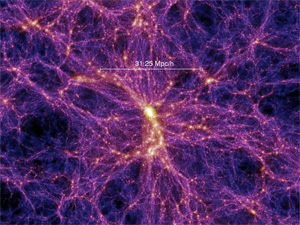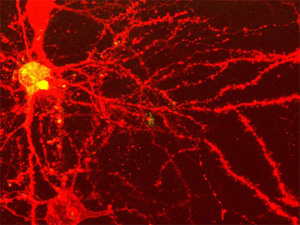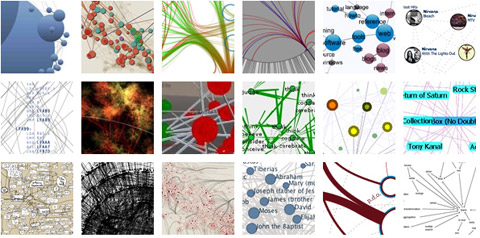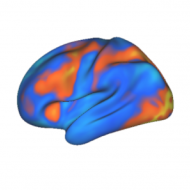 This image is not of a neuron.
This image is not of a neuron.
This image is of the other universe; the one outside our heads.
It depicts the “evolution of the matter distribution in a cubic region of the Universe over 2 billion light-years”, as computed by the Millennium Simulation. (Click the image above for a better view.)
The next image, of a neuron, is included for comparison.

It is tempting to wax philosophical on this structure equivalence. How is it that both the external and internal universes can have such similar structure, and at such vastly different physical scales?
If we choose to go philosophical, we may as well ponder something even more fundamental: Why is it that all complex systems seem to have a similar underlying network-like structure?
For illustration of this point, just take a glance at the front page of VisualComplexity.com (partially reproduced below).

These neural-network-like visual images represent complex systems and relations for domains as diverse as academic citations, the blogosphere, scientific knowledge, genealogy, iTunes music collections, and Italian wine production.
Does this imply some deep equivalence exists between all complex systems? Is it the nature of complex systems to be network-like?
Alternatively, this is perhaps simply how we, as neural networks, are able to conceptualize the external universe. Could it be that the external universe is vastly different in form from our internal universe, but we simply perceive that which happens to be compatible with our neural network knowledge structure?
It seems there are some situations where we have trouble representing reality for this reason. However, evolutionary pressures for survival likely drove the human brain to represent the world as accurately as possible. (Otherwise, e.g. our ancestors may have believed lions disappeared when hiding behind bushes; an obviously maladaptive representation of reality.) This suggests that even though our brains don’t represent the world with complete accuracy, it is nonetheless quite accurate in most cases.
Ultimately I think the equivalence between complex systems is due to the underlying nature of such systems. They must all involve massive integrated differentiation. In other words, there must be many different things (nodes), with many different relations among them (links) for a system to be complex. Thus integrated differentiation, the very basis of complexity, is inherently network-like (i.e., has the equivalent of nodes and links).
It is compelling to consider if neural systems, with their numerous nodes (neurons) and links (synapses) providing integrated differentiation, might have evolved complexity in order to represent other complex systems. In other words, neural systems may have evolved in order to mirror the complexity presented by the external universe, which helped each organism adapt and survive in its environment.
Thus the similarity between the internal and external universes may not be due to coincidence, but design.
-MC (Michael W. Cole)

This is a result of design. Compley Systems have similarities, described by Hegels ‘Dialectic’.
Nice topic :)
This statement is where I take exception:
This suggests that even though our brains don’t represent the world with complete accuracy, it is nonetheless quite accurate in most cases
accurate wrong word
@Recher
What word would you like to replace “accurate” with?
You haven’t convinced me that it is the “wrong word” to use here.
how is it that, from an evolutionary point of view, we have mirrored the external universe? I mean its probable that the neural connections and semantic associations are related. But how would the early organism have had any impression of the cosmos to mirror it?
If that’s not what you’re saying, rather you’re pointing out that there is something fundamentally comparable between the two, like the fact that connections are things that link two points, and many points make make connections. And when particular points have many connections they become a centralized passing point… then you havnt said much
@HA!
The argument is that the brain has mirrored the external universe because there were many evolutionary advantages to do so. The example was the adaptive nature of representing lions even if they hide behind bushes. This increased complexity in the brain, which mirrors the external world, makes it more likely to survive in the wild (providing an evolutionary advantage).
I'm not arguing that the ultimate evolutionary goal of the brain is to completely mirror the external universe. There are also evolutionary advantages to self-deceptive tendencies (e.g., males believing females are just 'playing hard to get' during courtship even if they are clearly indifferent toward the pursuing male during most of the process).
As far as the visual similarity between the entire external universe and the brain, the idea is that all complex systems look similar. Since the brain is 'trying' to approximate a complex system (the part of the universe leading to evolutionary advantages), it becomes a complex system. Since both the brain and universe are complex systems they have a network-like structure that makes them look similar.
This is a beautiful proof of cretion. This similarities represent the design structure and style of ONE creator.
@Turgut
I strongly disagree with the creationist interpretation. There is a clear mechanism for evolution here, as I described. There is no clear (or even conceivable) mechanism for how an all-powerful human-like creator would have come into existence.
HA! said: But how would the early organism have had any impression of the cosmos to mirror it?
They did not needed to have any impression. It is enough that they recived particular amount of information.
See: Claude Shannon “The Mathematical Theory of Information”
See: Erwin Schrodinger “What is the live?”
M.C.
I find your observation very interesting, however I have some doubts about so general conclusion.
This is quite well argumentation as for naturalized rationality, however i’m not sure if this is proper one for the claim. I mean that it is possible to use such kind of evolutionary argumentation if one want to show that our epistemic abilities are, let say, somehow adeqate.
But in my opinion we should distinguish between our abilities to represent data in some way, and real nature of the universe. Even if one would find really interesting way to show a priori that some complex structures are somehow similar, this would be interesting theoretical discovery. It may say something about the structure of cognition, and mind, but nothing really interesting about the mind-world suitability. Our concept of universe and its complexity is not independent to our mental machinery. You never know what kind of information you loose becouse of yours mind architecture. Thus you never know how you could imagine universe having another cognitive structure. But the real problem is that cognitive architecture of mind is not strictly dependent to the brain hardware (wetware). Let say: I do not belive this. If you treat abitily of representing the lion in bushes as a program, there is no limitation for kind of hardware on which it is implemented.
That is what I think of that matter.
I think Turgut’s point is interesting. The phenomena depicted in the images suggests some higher law or principle that applies at both scales. To what extent can it really be said that the matter in the universe is subject to evolutionary pressures (to survive)? Is there any conceivable sense in which galaxies are recombining some kind of genetic code and generating offspring? Can they be said to be evolved?
@P.L.
I wasn’t saying that the physical universe evolved in the same way as biological evolution. Rather, I was saying that brain evolution may tend toward mirroring the universe in complexity. Thus, I was saying that the evolution is all on one side.
That being said, there is a similar evolutionary algorithm likely at work both with the large-scale physical universe and the brain. That algorithm simply consists of systems entering into random states (like mutations) with the ones that are most stable lasting the longest (like selection). These long-lasting states then recombine into more complex longer-lasting states, thus evolving order and complexity over time.
So, now I am indeed saying that the brain and the universe evolved complexity in some equivalent (though obviously not identical) way. Of course, since the brain is part of the universe it seems that biological brain evolution is in fact a subset of a larger class of evolutionary processes occurring at multiple scales in the universe.
P.L.
This suggestion is far more convinceing. It is possible that all the structures in universe depend on the same law of development. We could say evolutionary law, which accepts some structures, and their iterations and deny others. This approach can be applied to both brain, and cognition. Mayby we can apply it as well to the universe… I am not sure. We should ask phisician about conclusion of this type.
Turgut
Anyway this is not enough for any claim about creation, and FAR TOO LESS for any statement about any CREATOR.
To summarize, here are the three explanations I’ve given of the brain-universe equivalence:
1) All complex systems look similar. Since the brain and the large-scale universe are complex systems they will tend to look similar.
2) There are evolutionary advantages for organisms whose brain resembles the universe, since this allows for prediction and careful planning to avoid danger and gain reward (e.g., food). Since the brain tends to mirror the universe it will tend to look like the universe.
3) The universe implements an algorithm in which configurations of matter are combined pseudo-randomly, with those configurations that are most stable lasting the longest (by definition). These stable configurations are then recombined with other stable configurations, potentially creating even more stable configurations. Note that the more stable the configurations the more chance it has for combining with other stable configurations, thus the more likely it is to enter into an even more complex and/or stable configuration. Also note that the main difference between this form of evolution and biological evolution is the lack of replication in the case of the large-scale universe (similarity between structures is dependent on co-evolution).
I think I like the last explanation the best, though I’ll add this synthesis of 1 and 3 to make an even better explanation:
4) A common algorithm is at play for both large-scale (e.g. galactic) and small-scale (e.g. brain) evolution. This algorithm leads to high stability and/or complexity over time. The large-scale universe and the brain have become complex over millions of years. Since complex systems tend to look similar the brain and large-scale universe look similar.
It would seem that the parallels drawn could simply be put down to how we have chosen to abstract the data, it is the human condition to seek recognisable patterns. The ancient Chinese came up with this idea first of course, in that everything is built up from a fundamental pairing of opposites (yin/yang or binary if you wish). All matter in the universe is basically different manifestations of Hydrogen, or to be even more basic everything that exists is simply a manifestation of energy (E=mc2) it shouldn’t surprise us to observe that the natural ordering of stable systems should follow similar patterns. I would be more surprised to observe something that seems so far out of our expected natural orders… I guess that’s why QM sits so badly with some of us.
God really doesn’t play dice with the universe, perhaps.
See Timothy Ferris’ “The Mind’s Sky”
It’s a deep and informed meditation on exactly this subject.
The main reason that we see this similarity between an aspect of the brain and an astronomical picture is the choice of *scale* for each which highlights the correspondence. At other scales (for each), zoomed in or out, we would see something quite different.
Heylighen,
http://www.timesonline.co.uk/tol/news/uk/science/article1395798.ece
explains this well.
Sorry, error in previous post. URL should be:
http://pespmc1.vub.ac.be/COMPLEXI.html
I couldn’t understand some parts of this article Two Universes, Same Structure, but I guess I just need to check some more resources regarding this, because it sounds interesting.
So the Earth doesn’t really resemble a marble? It’s only careful scaling that makes it look that way?
Very nice images. Instead of going into philosophical explanations, why not consider that they follow the same type of physical laws: stars follow gravitational laws whereas neuronsor the molecules forming them follow electrostatic laws, both laws are 1/r^2 potentials ?
Igor.
Maybe we just see everything as connected in large networks because that’s the way our nervous systems is laid out, and reality may be something entirely different….
What if the universe itself was just a giant neuron in some giant creature?
What if Justin is right, and everything around us was just a thought in God’s mind?
The answer is very simple really: The cosmos functions as a giant brain, and we are merely thoughts and dreams of this Entity, and so mirror its Own design…just as our dreams are unsubstantional to us, and we perceive matter to “exist”, to be “solid”, for this Entity, we are but wraith-like, matter, dimensions, physical laws being to It, the product of Its imagination…since ALL matter is really energy, what is so surprising about it? You are a dream, I am a dream, our reality is nothing but a dream, for an Entity at this level…and so forth.